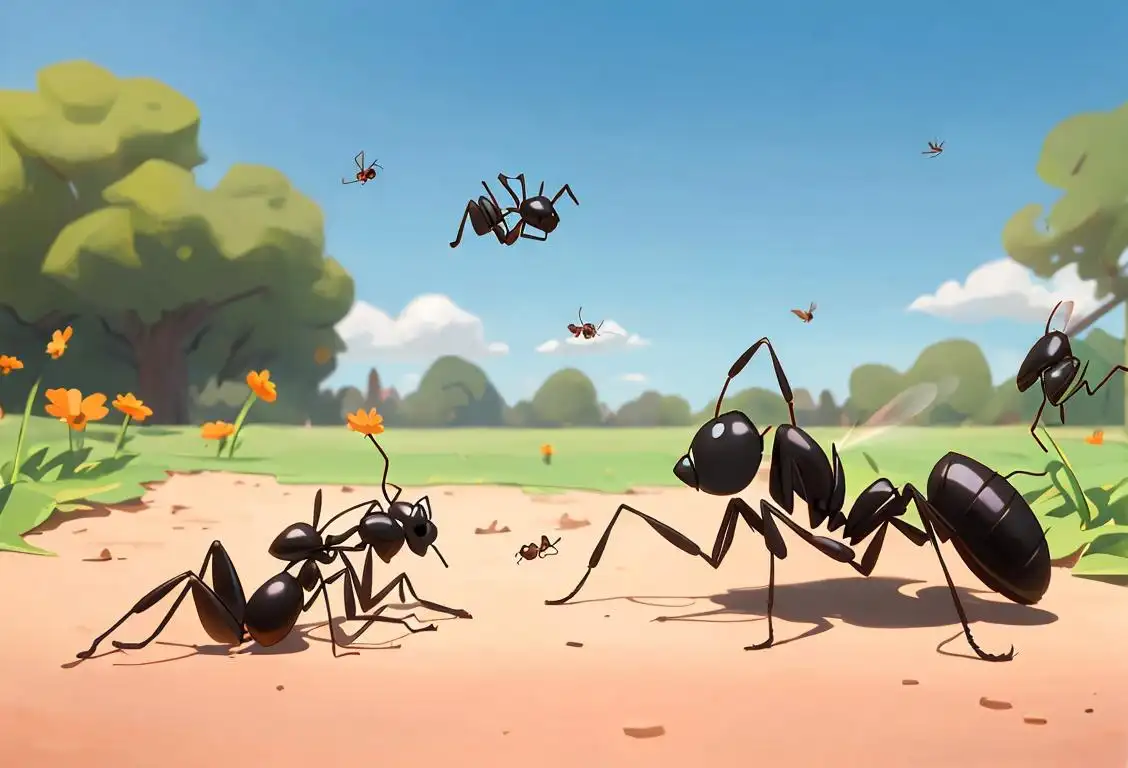National Flying Ant Day

Are you ready to take flight on National Flying Ant Day? Get your bug spray and pilot hats ready, because we're about to dive into the buzzing world of flying ants!
When is Flying Ant Day?
It's national flying ant day on the 5th July.
The Internet Buzz Around National Flying Ant Day
Every year on National Flying Ant Day, people from all over the internet come together to share their fascinating encounters with these airborne insects. With 22 mentions online, it's clear that these tiny winged creatures have captured the attention of many.
The most memorable Flying Ant Day happened on July 5, 2017, when social media was buzzing with excitement (and slight annoyances) about the annual event. Twitter users shared their experiences, from shrieks of terror to comical tales of ants crash-landing on picnics. It's safe to say that Flying Ant Day is anything but boring!
The Origins of National Flying Ant Day
But how did this curious celebration come to be? Well, National Flying Ant Day is not an officially recognized national day, but rather a quirky phenomenon that occurs in various parts of the world. It usually takes place during the summer months when several ant colonies release winged male and female ants for their annual nuptial flights.
These adventurous ants take to the skies in search of a mate and a new place to start their own colonies. It's a spectacular sight, but it can also lead to swarms of ants invading parks, gardens, and even homes.
No one knows exactly why some days are particularly buzzing with flying ants, but scientists speculate that weather conditions, such as warm and humid days after a rainfall, may trigger their emergence.
Did You Know?
Did you know that flying ants are not a specific species? They are actually regular ants, but during their nuptial flights, they grow wings and take to the skies. It's like their version of prom night, complete with fancy attire!
So, next time you see a swarm of flying ants, remember that they're just young ants looking for love...and a new home. And on National Flying Ant Day, let's celebrate their adventurous spirit and remind ourselves of the wonders of the insect world.
History behind the term 'Flying Ant'
1668
The First Recorded Mention
The term 'flying ant' was first recorded in 1668 by the English naturalist and physician Thomas Moffet. Moffet referred to these winged ants as 'flying ants' due to their ability to take to the air during their mating season. He observed their behavior and noted their distinct characteristics.
1893
The Discovery of Winged Ants as Reproductive Stage
In 1893, the French entomologist Auguste Forel made a significant discovery about flying ants. He recognized that these winged ants were actually the reproductive stage of the ant life cycle. Forel's observation helped shed light on the purpose and behavior of these flying ants during their swarm and mating season.
1935
The Studies on Ants by Sir Cyril Clarke
Sir Cyril Clarke, a British entomologist, made notable contributions to the understanding of ants, including flying ants. In 1935, he conducted extensive studies on ants and detailed their biology, behavior, and ecological importance. His research provided valuable insights into the life of flying ants and their role in ant colonies.
1940s
The Awareness of Flying Ant Day
Although the term 'flying ant' already existed, the general public became more aware of the phenomenon known as 'Flying Ant Day' in the 1940s. 'Flying Ant Day' refers to a specific day or period when large numbers of flying ants emerge for mating. It's a fascinating natural event that occurs annually during the summer in certain regions.
Recent Years
The Popularity in Social Media and Science Communication
In recent years, flying ants have gained significant attention on social media platforms and in science communication. People share videos, photos, and stories of swarms of flying ants, often during 'Flying Ant Day.' Scientists and entomologists also discuss the biology and ecological importance of flying ants, fostering a greater understanding and appreciation for these creatures.
Did you know?
Did you know that flying ants are not a specific species? They are actually regular ants, but during their nuptial flights, they grow wings and take to the skies. It's like their version of prom night, complete with fancy attire!Tagged
fun nature adventureFirst identified
29th June 2017Most mentioned on
5th July 2017Total mentions
22Other days
Park On A Sunny Day
Parks Will Be Free For Everyone Day
Desert Day
Park Is Beautiful At Both Times Of The Day
Parks One Day
Oregon Day
Find A Rainbow Day
Park All Day
Park For A Day
Park On A Cloudy Day









